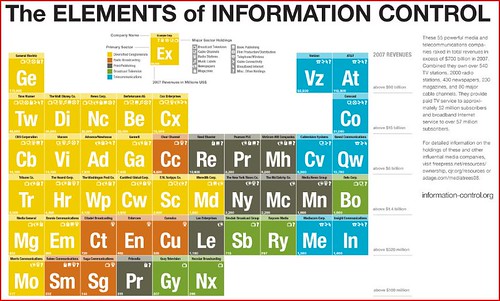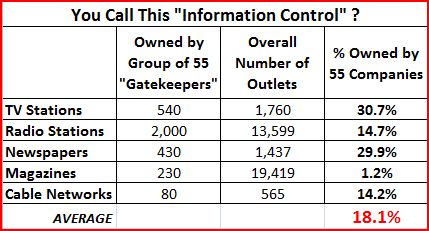[This represents a bit of a departure from the traditional format of my ongoing “Media Deconsolidiation Series,” but you will see how it ties in…]
So, some guy from the (Un)Free Press — the activist group that wants to regulate every facet of the media and broadband universe — has created a scary looking chart about “Information Control” [seen below]. It’s based loosely on the Periodic Table of Elements, you know, to give it the aura of science and fact. In reality, it’s just another silly scare tactic that tells us very little about the true nature of our modern media marketplace.

The chart is accompanied by the typical Free Press gloom-and-doom rhetoric about the unfolding media apocalypse. “Nearly everything you see, hear and read that isn’t from a friend — whether on TV, the radio, or even on the Web — comes from a for-profit gatekeeper.” And then comes the obligatory A.J. Liebling quote about how “Freedom of the press belongs to those who own one,” followed quickly by the typical punch line about how just a handful of companies (in this case 55 of ’em) are puppeteering all our thoughts in America today:
Combined, these 55 powerful media and telecommunications companies raked in total revenues in excess of $700 billion in 2007. Together they own over 540 TV stations, 2000 radio stations, 430 newspapers, 230 magazines, and 80 major cable channels in the United States. They provide paid TV service to approximately 52 million subscribers and broadband Internet service to over 57 million subscribers. They’re the bottlenecks through which our news, our entertainment, and our political discourse must travel. What they want to promote becomes prominent; what they suppress stays out of the mainstream. As such, these companies are the elements of information control.
Oh my God! We are all just brainwashed sheep!
Except we’re not. It amazes me how these “information control” and “media monopoly” myths keep getting widespread circulation. But the first thing to note is how the media reformistas can’t get even their story straight when it comes to how many “monopolists” are supposedly out there today. As I noted in my 2005 book, Media Myths: Making Sense of the Debate over Media Ownership, the critics seem to just pull their numbers out of a hat. Some say as few as 3 companies control everything. Others says 5 or 6. Still others say it might be a few dozen. And now this guy says its 55. Hey, that’s progress that even the Free Press should love!
Regardless of the number, does this really represent the totality of our modern media universe? Do those 55 companies really “own most of the 21st-century presses in America” as the “Info Control” website states? Answer: NOT. EVEN. CLOSE. Here are the facts. [I happened to have compiled them for a PFF special report entitled Media Metrics: The True State of the Modern Media Marketplace to debunk myths just like this.]
In the table above, I have taken the number of media outlets owned by the 55 companies and then divided it by the total number of media outlets. This gives us the actual percentage of media outlets owned by the 55 media providers listed in the “Information Control” chart. Needless to say, it’s hard to see how anyone can claim “bottleneck” control or “media monopoly” when an average of just 18% of all those outlets are owned by the 55 companies! And what that number doesn’t tell you is that — as my “Media Deconsolidation” series has been illustrating over the past two years — America’s media marketplace has been growing less concentrated with each passing month. Media companies are selling off and shedding assets and divisions faster than ever. There’s a 24-hour death watch going on over at Twitter these days on the “Media is Dying” thread if you care to follow the carnage in less than 140 characters at a time.
Oh, here’s another problem with the “Information Control” chart: Where exactly does the Internet fit into the picture? Answer: It doesn’t. They’ve conveniently left out the Net, online media, blogging, social networking, podcasting, and other bottom-up, user-generated content and forms of communication.
But let’s ignore the Internet and all those new Digital Age options for a moment. Let’s say this guy had it right and that only 55 companies really did control “Nearly everything you see, hear and read.” The fact is, that really wouldn’t be the end of the world. 55 competitors would be considered a luxury in just about any other major economic sector. Care to draw up a “Periodic Chart” for autos, airlines, supermarkets, or semiconductors? If one did, there would be far fewer squares on it. The fact is, even if we accepted the artificial limitations of this chart, we’d still have a lot of choices at our disposal.
But we need not accept those limitations. We live in a different world; a better world. With far more choices and diversity than this silly chart indicates. Indeed, by every conceivable measure we have more media options and diversity than we did 30 years ago. Magnitudes more. I bet the guy who put this chart together isn’t even old enough to remember when three old white guys in bad suits delivered us a half-hour of news each night at 6:30, and if we weren’t lucky enough to be sitting in front of our TVs at that exact moment, then we were screwed. Compare that pre-1980 reality to today and the unprecedented information cornucopia at our disposal. In my lifetime (I’m 40) we have seen the death of mass media and the end of “appointment-based” media consumption. Media providers no longer call the shots; we the viewing and listening public do.
But shhhhh… we’re not suppose to talk about these meddlesome things called facts. You see, the entire media policy drama in this country is based on a glorious set of mega-myths. There’s a handful of nefarious schemers aiming to program our little minds with corporate propaganda, or so the story goes. They must be stopped. At all costs. Luckily, the enlightened few at the Free Press and other media reformista outfits have managed to avoid the corporate brainwashing — My God, how did they ever do it! — and so they are ready to lead us to the media promised land. But to get there, we must first burn the village to save it. We must destroy free media (as in free-market, for-profit media) to rebuild free media (as in media controlled by government masters). Only then will we enter Information Nirvana and liberate our minds from our evil corporate overlords!
Or so the story goes.
(P.S. Brian Anderson and I recently penned a book to counter these fantasies and the efforts by the media reformistas to remake the media marketplace in their preferred image. See: A Manifesto for Media Freedom, Encounter Books, 2008).


 The Technology Liberation Front is the tech policy blog dedicated to keeping politicians' hands off the 'net and everything else related to technology.
The Technology Liberation Front is the tech policy blog dedicated to keeping politicians' hands off the 'net and everything else related to technology.